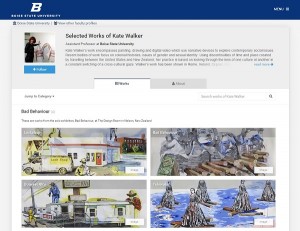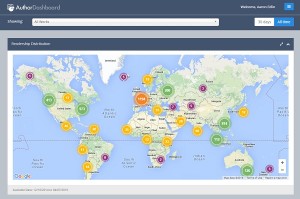2018 School Spending Survey Report
SelectedWorks Redesigned for Librarians
Academic profile platform SelectedWorks has been redesigned and was recently relaunched as a librarian-facing faculty support tool, enabling academic libraries to manage the creation and organization of consistent, institution-branded faculty profiles that showcase open access articles and other scholarly work. The redesign was the result of “a change in understanding” of how the platform was being used, according to Jean-Gabriel Bankier, president and CEO of bepress, developer of SelectedWorks, as well as the Digital Commons institutional repository software suite and other academic publishing and communication products.
 Academic profile platform SelectedWorks has been redesigned and was recently relaunched as a librarian-facing faculty support tool, enabling academic libraries to manage the creation and organization of consistent, institution-branded faculty profiles that showcase open access articles and other scholarly work. The redesign was the result of “a change in understanding” of how the platform was being used, according to Jean-Gabriel Bankier, president and CEO of bepress, developer of SelectedWorks, as well as the Digital Commons institutional repository software suite and other academic publishing and communication products. “When we built SelectedWorks in 2004, the idea was that faculty would be able to own [their profiles] and run them themselves, and then the library would harvest and collect the scholarship that they wanted” when faculty updated their profiles and uploaded or shared content, Bankier told LJ. “It was going to be an institutional repository feeder.” But in practice, that was often not how it was used. Instead, academic libraries and institutional repository managers—many of whom are often looking for ways to encourage faculty to submit content—had been using SelectedWorks to create and manage these profiles as a service to faculty. "We’re able to show how much our faculty really publishes, and it’s great for professors to get that recognition," Beverly Lysobey, Digital Commons and resource management librarian at Sacred Heart University (CT), explained in a press announcement. "We’ve had several faculty members approach us for help making sure their record was complete when they were up for tenure, and we’ve even found articles that authors themselves no longer had access to.” The redesigned platform features profile navigation that allows librarians to move more quickly between faculty bio information, works, readership reports, the institution’s website, and other faculty profiles, as well as a new menu for user-defined categories of works, displaying an institution’s full array of works in that user-defined topic. Integration with Digital Commons repositories has been enhanced with an administrator notification center, enabling librarians to monitor the addition or removal of works by faculty, as well as any changes or updates that faculty post to their SelectedWorks profile. Metadata generated in Digital Commons is now automatically captured in SelectedWorks (and vice versa), ensuring consistent download counts and readership reports. In addition, profile pages now include multimedia support, enabling the display of streaming media, datasets, images, video, teaching materials, presentations, and other content, facilitating the creation of richer profiles. Once profiles are created, ongoing maintenance and updating tends to be a collaborative effort between the faculty and the library, Bankier said. This has not changed with the redesign, although features like the administrative notification center will give libraries additional oversight. The faculty profile interface was designed for simple updating and content uploads, similar to LinkedIn or Facebook. “The faculty member is given access [to their profile] to organize the contents and decide how to display the material,” Bankier said. “There’s some flexibility for how the institution wants to work with faculty and how faculty wants to work with the library. It’s flexible enough to give authors access and control, still with library oversight.”
Academic profile platform SelectedWorks has been redesigned and was recently relaunched as a librarian-facing faculty support tool, enabling academic libraries to manage the creation and organization of consistent, institution-branded faculty profiles that showcase open access articles and other scholarly work. The redesign was the result of “a change in understanding” of how the platform was being used, according to Jean-Gabriel Bankier, president and CEO of bepress, developer of SelectedWorks, as well as the Digital Commons institutional repository software suite and other academic publishing and communication products. “When we built SelectedWorks in 2004, the idea was that faculty would be able to own [their profiles] and run them themselves, and then the library would harvest and collect the scholarship that they wanted” when faculty updated their profiles and uploaded or shared content, Bankier told LJ. “It was going to be an institutional repository feeder.” But in practice, that was often not how it was used. Instead, academic libraries and institutional repository managers—many of whom are often looking for ways to encourage faculty to submit content—had been using SelectedWorks to create and manage these profiles as a service to faculty. "We’re able to show how much our faculty really publishes, and it’s great for professors to get that recognition," Beverly Lysobey, Digital Commons and resource management librarian at Sacred Heart University (CT), explained in a press announcement. "We’ve had several faculty members approach us for help making sure their record was complete when they were up for tenure, and we’ve even found articles that authors themselves no longer had access to.” The redesigned platform features profile navigation that allows librarians to move more quickly between faculty bio information, works, readership reports, the institution’s website, and other faculty profiles, as well as a new menu for user-defined categories of works, displaying an institution’s full array of works in that user-defined topic. Integration with Digital Commons repositories has been enhanced with an administrator notification center, enabling librarians to monitor the addition or removal of works by faculty, as well as any changes or updates that faculty post to their SelectedWorks profile. Metadata generated in Digital Commons is now automatically captured in SelectedWorks (and vice versa), ensuring consistent download counts and readership reports. In addition, profile pages now include multimedia support, enabling the display of streaming media, datasets, images, video, teaching materials, presentations, and other content, facilitating the creation of richer profiles. Once profiles are created, ongoing maintenance and updating tends to be a collaborative effort between the faculty and the library, Bankier said. This has not changed with the redesign, although features like the administrative notification center will give libraries additional oversight. The faculty profile interface was designed for simple updating and content uploads, similar to LinkedIn or Facebook. “The faculty member is given access [to their profile] to organize the contents and decide how to display the material,” Bankier said. “There’s some flexibility for how the institution wants to work with faculty and how faculty wants to work with the library. It’s flexible enough to give authors access and control, still with library oversight.”  Faculty with active profiles automatically receive monthly reports highlighting how often their work is being read, and can log in to SelectedWorks to view a personalized author dashboard to analyze readership by time frame and individual or collected works. Using widgets such as interactive maps, they can view readership by region, country, or institution. Librarians, using an administrative dashboard, can access this information at the profile or institutional level. Bankier suggested that creating and administering the profiles offers librarians an opportunity to open a dialog with individual faculty members or departments, which could lead to discussions about other library services or opportunities for partnership. “If you think about academic libraries today, they’re looking for ways to serve faculty needs—to engage them and learn about their research,” Bankier said. “And what better way to do that than to say ‘let’s talk about you, let’s talk about your work, and build a beautiful [online] profile of your scholarship.’”
Faculty with active profiles automatically receive monthly reports highlighting how often their work is being read, and can log in to SelectedWorks to view a personalized author dashboard to analyze readership by time frame and individual or collected works. Using widgets such as interactive maps, they can view readership by region, country, or institution. Librarians, using an administrative dashboard, can access this information at the profile or institutional level. Bankier suggested that creating and administering the profiles offers librarians an opportunity to open a dialog with individual faculty members or departments, which could lead to discussions about other library services or opportunities for partnership. “If you think about academic libraries today, they’re looking for ways to serve faculty needs—to engage them and learn about their research,” Bankier said. “And what better way to do that than to say ‘let’s talk about you, let’s talk about your work, and build a beautiful [online] profile of your scholarship.’” RELATED
RECOMMENDED
TECHNOLOGY
ALREADY A SUBSCRIBER? LOG IN
We are currently offering this content for free. Sign up now to activate your personal profile, where you can save articles for future viewing









Add Comment :-
Comment Policy:
Comment should not be empty !!!
AM
The newly designed selected works interface has removed the Mailing List tool which was used to invite colleagues to subscribe to a selected works account and to announce scholarship and send messages about new content. This was done without informing account holders. As a faculty with a selected works account, this change purged my entire mailing list. Selected Works support never responded to my email note about this issue.Posted : Jul 20, 2016 07:05